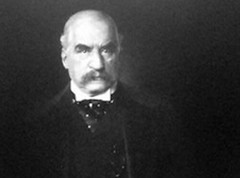
PREV ARTICLE
NEXT ARTICLE
FULL ISSUE
PREV FULL ISSUE
J.P. MORGAN'S 1895 COIN LOOPHOLE GAMBIT
Numismatists and researchers should enjoy this related story of how financier J.P. Morgan once used a different obscure coin loophole to save the American economy in 1895.
-Editor
But the federal government exploiting obscure loopholes under moments of extreme duress is not without precedent. At the beginning of 1895, the country was facing default after its gold reserves evaporated. But through some legal archaeology JP Morgan located an obscure, Civil War-era statute that would allow he and some fellow international financiers to replenish the Treasury's gold stocks. The country was saved. With the help of Bancroft Prize-winner Jean Strouse's biography "Morgan," we retell the story. Fearing rising U.S. demand for cheap money, foreign investors continue to sell American securities and take the proceeds home. Between 1890 and 1894 anxious creditors unload $300 million worth of American securities and transferred gold abroad. "Since there was no income tax and the government had no power to issue money, the Treasury had to buy or borrow gold in order to maintain its reserve. By February 1894, Treasury was losing over $2 million a day. The government would default in three weeks' time. Morgan's been mulling the problem. He reasons that he could probably corral a group of international bankers to buy out a new bond issue, but the government would have to back it in gold or sterling. But the problem again: Congress must authorize all gold bond issues. Thirty-three years [before], in the throes of the Civil War, Congress had authorized Treasury Secretary Salmon P. Chase to issue bonds that could be offered for coin. If the gold bailout Morgan was proposing could be considered a bailout in coin, it would not require Congressional approval. The final terms are struck, with the government agreeing to get slightly hosed. The government will buy 3.5 million ounces of gold coin from the bailout team at $17.80 per ounce, in exchange for $62.3 million worth of 30 year bonds paying 4%. The price of gold is actually $18.60, so the government ends up paying for $65.1 million in gold in exchange for $62.3 million in bonds — paying a $3 million premium. The syndicate would have six months to complete the contact, and would procure half the new gold abroad at a rate not exceeding 300,000 ounces a month. Twelve days later, the bond issue was offered and sold out in 20 minutes.
To read the complete article, see:
The True Story Of The Time JP Morgan Saved America From Default By Using An Obscure Coin Loophole
(www.businessinsider.com/morgan-1895-crisis-and-1862-gold-loophole-2013-1)
The Numismatic Bibliomania Society is a non-profit organization promoting numismatic literature. See our web site at coinbooks.org. To submit items for publication in The E-Sylum, write to the Editor at this address: whomren@gmail.com To subscribe go to: https://my.binhost.com/lists/listinfo/esylum All Rights Reserved. NBS Home Page Contact the NBS webmaster 
|
